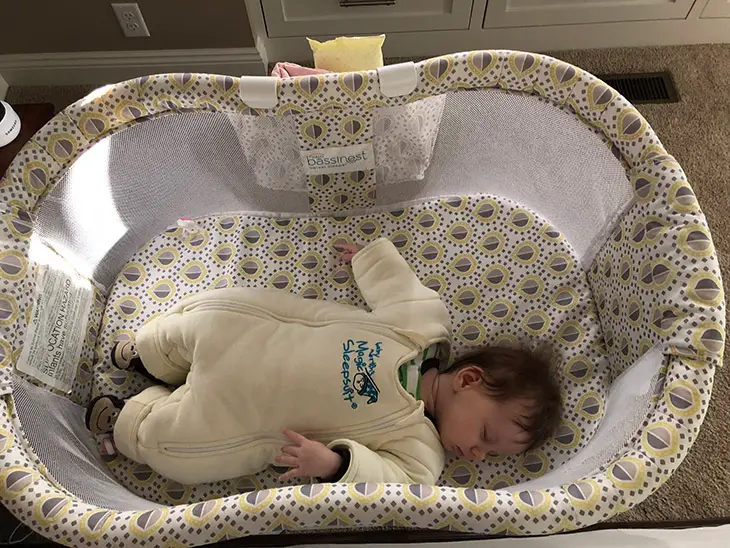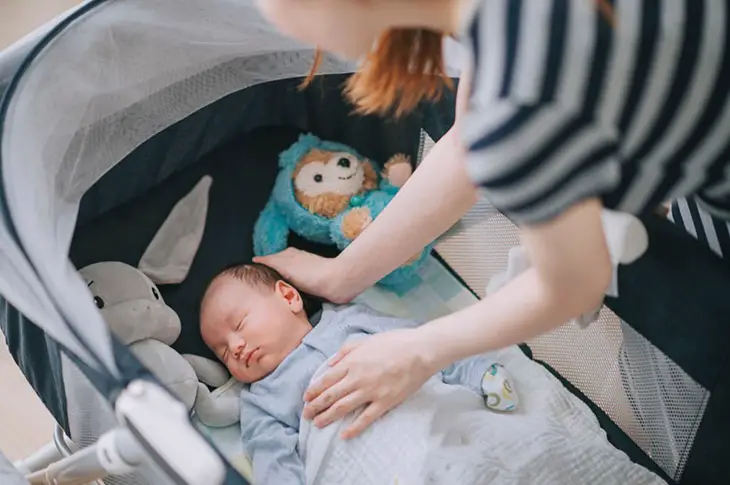The Halo Bassinest is popular for new parents who want their baby nearby at night.
This bedside sleeper allows for easy access to your child while keeping them safe in their sleep space at night time.
However, as your kid grows, you may wonder when it’s time to transition from bassinet to crib.
When to stop using halo bassinest? We’ll cover the factors to consider when to stop using the Halo Bassinest.
What Is Halo Bassinest?

Halo Bassinest is a bedside bassinet brand that provides a safe sleep solution for infants.
These products are designed to fit snugly beside a parent’s bed, allowing the baby to sleep within arm’s reach while maintaining a separate sleep environment.
The device features a swiveling mechanism that allows the bassinet to rotate 360 degrees, making it easy for parents to access their baby for late-night feeding or comforting at nighttime sleep.
Also, the swivel sleepers have a retractable sidewall, bringing the newborn baby closer for bonding, and a soothing center that includes an amber nightlight, white noise, and vibration.
When To Stop Using Halo Bassinest?
When to stop bassinet?
For safety issues, do not use it when your baby exceeds the halo bassinest age and weight limit, starts showing signs of pushing up on hands and knees, or begins rolling over.
Additionally, if your kid’s habits change or there is a lack of sleep surface in the portable bassinet, it may be time to move to a crib.
Ages
The Halo Bassinest age limit can vary depending on the growth and development of the baby.
Typically, the appliance is used for children up to about 5-6 months of life or until they start to show signs of pushing up or rolling over on their hands and knees.
It is important to note that each baby grows up at their own pace.
So monitor your infant and pay attention to their behavior and movements to determine when it’s time to change from bassinet to crib.
Maximum Height Or Weight Limit
How long can baby sleep in Halo bassinest?
According to the manufacturer’s standards for bassinest, the maximum weight limit for this baby product is usually around 20-30 pounds, depending on the specific model.
Exceeding the weight or bed height limit can pose a safety risk as the child may outgrow the space and become too heavy or too long for it, causing the bassinet to tip over or collapse.
Signs Of Pushing Up On Hands And Knees
Halo Bassinest when to stop using? This normally occurs between 3 and 4 months, when the baby establishes large motor abilities.
As the baby begins to push up on their hands and knees, the lightweight bassinet can easily topple over, posing a danger of damage.
Rolling Over
As your kid begins to roll over after a period of time, it is time to stop employing the Halo Bassinest.
This is due to the possibility of a rolling infant accidentally pushing against the edges of the Bassinest and tipping it over.
Rolling can occur between 3 and 6 months, so you should prepare for this additional milestone and have a strategy when it happens.
Baby’s Sleep Habits
If your baby starts moving around in their sleep, tries to crawl out of their bassinet, or routinely wakes up at night and seems uncomfortable or cramped in the device, it may be time to make a shift.
Safety Concern
Acceptable safety standards are vital when deciding whether to cease using the Halo Bassinest.
By the time your baby has outgrown the bassinet and is attempting to climb out or is in danger of falling out, you need to move them to a safer sleeping arrangement, such as a mini crib or a crib.
Moreover, if the appliance has broken or damaged pieces or is not sturdy and secure, it is unsafe to use.
How To Safely Use The Halo Bassinet For Infants?

The Halo Bassinest is a popular bedside bassinet that provides a safe cocoon for infants. To use it safely, it is important to follow these safe sleep guidelines:
Follow The Manufacturer’s Instructions
When you use the device for your child, be in line with the manufacturer’s instructions.
Each bassinet may have unique features and requirements, so reading the instruction manual before use is crucial.
Some important factors to consider include assembling the appliance correctly, adjusting the height, and attaching it securely to your bed.
Place The Bassinet In A Safe Location
The bassinet should be placed where it won’t be knocked over or bumped into by others.
Put it away from windows, blinds, or cords your baby could tangle in. Additionally, avoid setting up the bassinet near any heat sources or radiators.
Use A Firm, Flat Mattress
It’s recommended to use the mattress that came with the bassinet, as it has been specifically designed to fit properly.
If you need to replace the mattress, choose one that meets the safety standards and guidelines for infant sleep.
A soft or sagging mattress can increase the danger of suffocation or sudden infant death syndrome (SIDS).
Keep The Bassinet Clear Of Any Loose Items
Maintaining the bassinet free of loose materials that might suffocate the infant is necessary. Pillows, blankets, and toys fall under this category.
The only object in the space with the infant should be a fitted sheet over a firm, flat mattress.
Use an infant-specific wearable blanket or sleep sack if more warmth is required.
Monitor Your Baby Regularly
Regular monitoring can assist you in detecting any problems or pain your baby may be feeling. Confirm that your child is breathing normally and not in any distress.
Parents should check on their newborns every few hours, and anytime they wake up.
Furthermore, get medical treatment right away if you detect any strange behavior or indications of pain, such as fussiness, excessive weeping, or difficulty breathing.
FAQs
How Long Can Baby Sleep In Halo Bassinet?
The recommended duration for using a halo bassinet is up to five months or until the baby shows signs of pushing up on hands and knees, rolling over, or outgrowing, whichever comes first.
It is important to note that every baby is different and may transition out of the bassinet at other times.
Also, if the baby has any health or medical conditions, consult a healthcare provider for individual recommendations.
What Age Should a Baby Move to Their Room?
Newborns should preferably share the same space as their parents throughout the first six months or at least for the first year.
After that, the babies should move to their rooms for better sleep quality and reduce the risk of sudden infant death syndrome (SIDS).
However, moving the baby to their room ultimately depends on the parents’ preference and the baby’s individual needs.
Some babies may be ready to move to their own cocoon earlier, while others may need to stay in their parent’s room longer.
Conclusion
The Halo Bassinest is a convenient and secure option for newborns, but switching your child to a crib is important when they outgrow the sleeping space.
When to stop using halo bassinest? Considering their age, weight, and developmental milestones, you can ensure a smooth and safe transition for your little one.
As always, consult your pediatrician with any concerns or questions.
